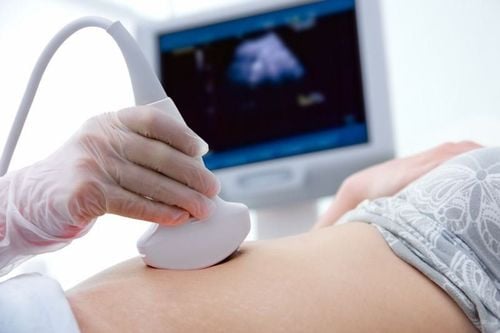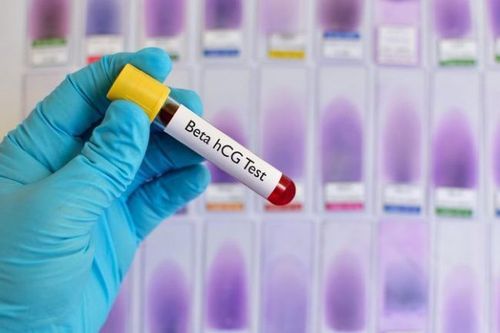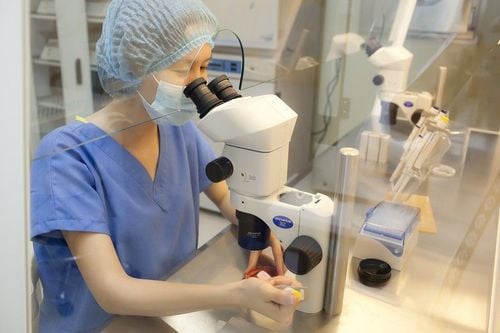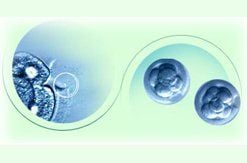This is an automatically translated article.
The article was professionally consulted by Specialist Doctor II Huynh Thi Hien - Obstetrician and Gynecologist - Department of Obstetrics and Gynecology - Vinmec Nha Trang International General Hospital.Primary infertility is infertility when the wife has never been pregnant, after 1 year of marriage, she has not become pregnant despite having normal intercourse and not using birth control method.
1. What is primary infertility?
According to the World Health Organization (WHO), infertility is the inability of a couple to have children after 1 year of marriage despite not using contraception and having normal intercourse. For wives over 35 years of age, the period of "release" after 6 months without pregnancy has been assessed as infertile. In Vietnam, the infertility rate is about 7.7%, which means there are about 1 million infertile couples.Infertility is divided into 2 types: Primary Infertility and Secondary Infertility.
If secondary infertility is a condition in which a couple has become pregnant, but then can no longer become pregnant, then primary infertility is a condition in which the couple cannot get pregnant even though they have never conceived. Primary infertility is more common than secondary infertility with 70% of infertility cases. To treat primary infertility, it is necessary to depend on the cause in both husband and wife, then the doctor will have an appropriate treatment method.
2. Diagnosis of primary infertility

First, the doctor will do a physical exam and conduct tests to find problems in the woman's ovulation. Tests to diagnose primary infertility in women include:
Hysteroscopy; Check the reserve capacity of the ovaries; Hormone testing; Pelvic ultrasound; Check for ovulation. Methods of diagnosing primary infertility for men:
Similar to women, men will be clinically examined by doctors, and then run tests to find problems in the process of ejaculation and production. ejaculate. Tests to diagnose primary infertility in men include:
Semen analysis; Hormone testing; Scrotal ultrasound; Genetic testing; Testicular biopsy.
3. Primary Infertility Treatment
The principle of primary infertility treatment should be based on the cause of the disease. This is the basis for the doctor to come up with the most appropriate method. Treatments for primary infertility based on the cause include:Lifestyle changes:
Couples can manage primary infertility with healthy lifestyle changes. Limit foods high in fat and alcohol; Exercise regularly. Improve the condition of being too thin or too fat; Do not smoke, drink alcohol; Add healthy foods to improve sperm quality, not to affect ovulation and menstrual cycle.
Men need to have healthy living habits, limit alcohol, eat healthy foods to improve sperm quality.
Recommended video:
Infertility treatments: Hope for infertile and infertile couples
Using drugs
Primary infertility cases due to pathology will be prescribed by doctors to use medication or surgery based on the condition. Primary infertility treatment drugs by cause include: Using fertility drugs to stimulate ovulation for women with infertility due to ovulation disorders; Medicines to treat problems affecting male fertility such as erectile dysfunction, hormone imbalance... Antioxidants or special drugs to improve sperm quality; Antibiotics to treat inflammation, kill bacteria, make sperm healthy and easier to move.

Surgery is indicated in the following cases:
In women: Surgery to solve problems in the uterus such as endometrial polyps; scar tissue in the uterus; uterine septum...
In men : Surgical treatment of vas deferens; Varicose vein surgery in testicles ...
Assisted reproductive methods
In the case of having applied methods of using drugs, surgery, lifestyle changes...but no results, the Couples can look to assisted reproduction methods. Some of the main assisted reproductive methods include:
In vitro fertilization IVF : In this method, instead of sperm and egg joining together in a woman's fallopian tubes, they are combined in vitro. After the embryo is successfully created, it will be transferred back to the uterus for the embryo to implant and develop into a fetus. Intracytoplasmic sperm injection (ICSI): A good quality sperm is selected to be injected directly into the ovum to increase the chances of fertilization. After successful fertilization, the embryo will be cultured until the 3rd or 5th day and then transferred to the mother's uterus to implant and develop into a healthy fetus. Embryo support (AH): A method of thinning or opening the outer membrane of the embryo, increasing the ability of the embryo to adhere to the uterine lining, thereby increasing the ability of the embryo to implant. Blastocyst stage embryo transfer (5th day embryo): Blastocyst stage embryo transfer (5th day after egg retrieval) helps to increase implantation, increase pregnancy rate, and at the same time limit the risk of multiple pregnancies caused by The number of embryos to be transferred is less than the number of embryos transferred on day 2 or 3. In vitro maturation method: After oocyte aspiration, immature oocytes can be further cultured in the IVF laboratory. It takes about 24 to 48 hours to reach maturity. Only mature ovules are able to fertilize the sperm and develop into an embryo. Intrauterine Insemination (IUI) is a method of sperm washing, selecting healthy sperm to inject directly into a woman's uterus to increase the possibility of conception. Sperm collection by procedure in case of male infertility Receive oocytes, sperm and embryos... Cryopreservation of embryos, sperm and oocytes
Please dial HOTLINE for more information or register for an appointment HERE. Download MyVinmec app to make appointments faster and to manage your bookings easily.
Recommended video:Vinmec applies AI to culture embryos with IVF, opportunities for infertile families














